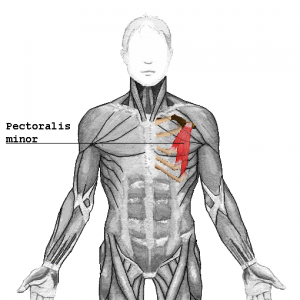Pectoralis Minor
Original Editor - Esraa Mohamed Abdullzaher
Top Contributors - Ilona Malkauskaite, Lucinda hampton, Esraa Mohamed Abdullzaher, Joao Costa, Ahmed Nasr and Kim Jackson
Description[edit | edit source]
The pectoralis minor is located under the pectoralis major, and both form the anterior wall of the axilla. The contracted muscle can be easily palpated there. It is also located close in relation to the brachial plexus and both the subclavian artery and vein, which all run between the muscle and the ribcage.[1]
Anatomy[edit | edit source]
Origin[edit | edit source]
It originates from the third to fifth ribs.[1]
Insertion[edit | edit source]
It inserts on the coracoid process of the scapula.[1]
Nerve supply[edit | edit source]
It is innervated by the medial and lateral pectoral nerves (C6-Th1), branches of the brachial plexus.[1]
Artery supply[edit | edit source]
The blood vessel that supplies the pectoralis minor muscle with blood is the thoracoacromial artery, which is a short artery that branches off the larger axillary artery of the chest and upper extremities.[2]
Function[edit | edit source]
The primary actions of this muscle include the stabilization, depression, abduction or protraction, upward tilt, and downward rotation of the scapula. When the ribs are immobilized, this muscle brings the scapula forward, and when the scapula is fixed, it lifts the rib cage. Both pectoralis muscles work with the serratus anterior muscles to create a full range of movement for the scapula.[3] With the scapula stabilized in a position of good alignment, the pectoralis minor acts as an accessory muscle of inspiration. [4]
Clinical relevance[edit | edit source]
Weakness[edit | edit source]
When pectoralis minor is weak, the strength of arm is diminished. Moreover, weakness of this muscle will increase respiratory difficulty in patients already suffering involvement of the respiratory muscles. [4]
Shortness[edit | edit source]
With the origin of this muscle on the ribs and the insertion on the coracoid process of the scapula, a contracture tends to depress the coracoid process of the scapula both forward and downward. Such muscle contracture is an important contributing factor in many cases of arm pain. With the cords of brachial plexus and the axillary blood vessels lying between the coracoid process and the rib cage, contracture of the pectoralis minor may produce impingement on these large vessels and nerves.
A contracted pectoralis minor restricts flexion of the shoulder joint by limiting scapular rotation and preventing glenoid cavity from attaining the cranial orientation necessary for complete flexion of the joint. [4]
Trigger points[edit | edit source]
Trigger points in pectoralis minor have almost identical referred pain patterns as in pectoralis major muscle.These pain patterns start in the front of shoulder and can extend down the inside of the arm, elbow, forearm, palm of the hand, and into the pinky, ring, and middle fingers. A tense pectoralis minor muscle can also entrap nerves in the armpit region that cause pain, numbness, and tingling to travel down the arm and into the hand.[5]
Assessment[edit | edit source]
Palpation[edit | edit source]
Power[edit | edit source]
Position: Supine. Fixation is not necessary by the examiner unless abdominal muscles are weak, in which case the rib cage on the same side should be held down firmly. Test: Forward thrust of the shoulder, with the arm at the side. Pressure: Against the anterior aspect of the shoulder, downward toward the table. [4]
Length[edit | edit source]
Position: Patient is supine with the arms at the sides, elbows extended, palms upward, knees bent and lower back flat on the table. Test: The examiner stands at the head of the table and observes the position of the shoulder girdle. The amount of tightness is measured by the extent to which the shoulder is raised from the table and by the amount of resistance to downward pressure on the shoulder. Tightness may be recorded as slight, moderate, or marked.
Treatment[edit | edit source]
Strengthening[edit | edit source]
Stretching[edit | edit source]
Manual therapy[edit | edit source]
Se also[edit | edit source]
Resources[edit | edit source]
- ↑ 1.0 1.1 1.2 1.3 https://www.kenhub.com/en/library/anatomy/pectoralis-minor-muscle (accessed 20 July 2018).
- ↑ https://study.com/academy/lesson/pectoralis-minor-function-blood-supply-innervation.html (accessed 20 July 2018).
- ↑ https://www.healthline.com/human-body-maps/pectoralis-minor#1 \(accessed 20 July).
- ↑ 4.0 4.1 4.2 4.3 Kendall F, McCreary E, Provance P,Rodgers M,Romani W. Muscles:Testing and function with posture and pain. 5th ed. Philadelphia: Lippincott Williams & Wilkins, 2005.
- ↑ http://www.triggerpointtherapist.com/?s=pectoralis+minor (accessed 19 July 2018).







